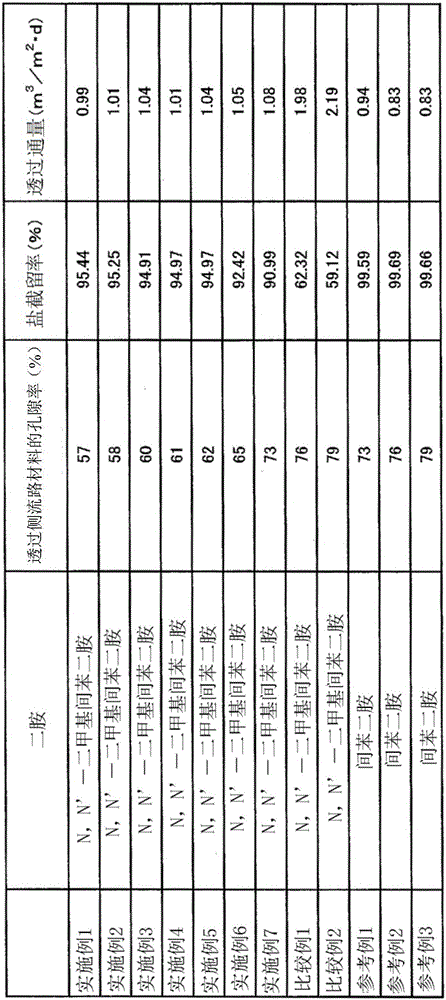Spiral-type separation membrane element
A separation membrane and spiral technology, which is applied in the field of spiral separation membrane elements, can solve the problems such as the skin layer is easily damaged and the salt retention rate is reduced, so as to achieve excellent oxidant resistance, lower salt retention rate, and omission or simplification of pretreatment. Effect
- Summary
- Abstract
- Description
- Claims
- Application Information
AI Technical Summary
Problems solved by technology
Method used
Image
Examples
Embodiment 1
[0062] An amine solution was prepared by dissolving 3% by weight of N,N'-dimethyl-m-phenylenediamine, 0.15% by weight of sodium lauryl sulfate, 2.5% by weight of triethylamine, and 5% by weight of camphorsulfonic acid in ethylene glycol. . In addition, 0.2% by weight of trimesoyl chloride and 0.4% by weight of isophthaloyl chloride were dissolved in Exxsol D30 (manufactured by Exxon Mobil, distillation range 130 to 160°C, boiling point 148°C) to prepare an acid chloride solution. And, the amine solution covering layer is formed by applying the amine solution on the porous support and removing excess amine solution. Next, an acid chloride solution is applied to the surface of the amine solution coating layer. Afterwards, the excess solution was removed, and further kept in a hot air dryer at 100° C. for 5 minutes to form a skin layer containing a polyamide-based resin on the porous support, thereby producing a composite semipermeable membrane.
[0063] Using the detection uni...
Embodiment 2~7、 comparative example 1 and 2
[0066] Except using the composite semipermeable membrane produced in Example 1, and using the permeation-side channel material of the warp-knitted fabric having the porosity described in Table 1, the permeation flux and Salt rejection.
[0067] Reference example 1~3
[0068] A composite semipermeable membrane was produced in the same manner as in Example 1, except that 3% by weight of m-phenylenediamine was used instead of 3% by weight of N,N'-dimethyl-m-phenylenediamine in Example 1. In addition, the permeation flux and salt rejection were measured in the same manner as in Example 1, except that the prepared composite semipermeable membrane was used as the permeation-side channel material of the warp-knitted fabric having the porosity described in Table 1. Rate.
[0069] [Table 1]
[0070]
[0071] As can be seen from Table 1, the composite semipermeable membranes of Examples 1 to 7 prepared using N,N'-dimethyl-m-phenylenediamine as the polyfunctional amine component ha...
PUM
| Property | Measurement | Unit |
|---|---|---|
| pore size | aaaaa | aaaaa |
| pore size | aaaaa | aaaaa |
| porosity | aaaaa | aaaaa |
Abstract
Description
Claims
Application Information
 Login to View More
Login to View More - R&D
- Intellectual Property
- Life Sciences
- Materials
- Tech Scout
- Unparalleled Data Quality
- Higher Quality Content
- 60% Fewer Hallucinations
Browse by: Latest US Patents, China's latest patents, Technical Efficacy Thesaurus, Application Domain, Technology Topic, Popular Technical Reports.
© 2025 PatSnap. All rights reserved.Legal|Privacy policy|Modern Slavery Act Transparency Statement|Sitemap|About US| Contact US: help@patsnap.com

